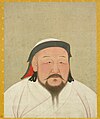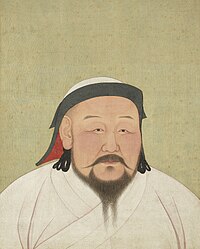Talaksan:YuanEmperorAlbumKhubilaiPortrait.jpg

Laki ng pasilip na ito: 480 x 599 na pixel. Ibang mga resolusyon: 192 x 240 na pixel | 385 x 480 na pixel | 616 x 768 na pixel | 821 x 1,024 na pixel | 1,642 x 2,048 na pixel | 3,221 x 4,018 na pixel.
Buong resolusyon ((3,221 × 4,018 pixel, laki ng talaksan: 13.02 MB, uri ng MIME: image/jpeg))
Nakaraan ng file
Pindutin ang araw/oras upang makita kung papaano ang itsura ng talaksan noong oras na iyon.
| Araw/Oras | Thumbnail | Mga dimensiyon | tagagamit | Kumento | |
|---|---|---|---|---|---|
| ngayon | 11:19, 21 Disyembre 2022 |  | 3,221 × 4,018 (13.02 MB) | Kcx36 | higher resolution |
| 12:46, 24 Pebrero 2021 |  | 2,678 × 3,200 (967 KB) | CAPTAIN MEDUSA | higher res | |
| 00:03, 13 Oktubre 2016 |  | 1,339 × 1,600 (1.54 MB) | Eugene a | True color | |
| 18:04, 7 Disyembre 2010 |  | 864 × 1,077 (123 KB) | Eugene a | Best version | |
| 18:21, 25 Nobyembre 2010 |  | 480 × 618 (120 KB) | Dirrival | a better version | |
| 04:43, 30 Setyembre 2010 |  | 517 × 640 (68 KB) | Wmpearl | ||
| 14:03, 28 Mayo 2008 |  | 877 × 1,103 (161 KB) | Yaan | == Summary == {{Information |Description = Shizu, better known as Khubilai. Portrait cropped out of a page from an album depicting several Yuan emperors (Yuandai di banshenxiang), now located in the National Palace Museum in Taipei (inv. nr. zhonghua 0003 |
Mga ugnay
Nakaturo sa talaksan na ito ang mga sumusunod na mga pahina:
Pandaigdigang paggamit sa file
Ginagamit ng mga sumusunod na wiki ang file na ito:
- Paggamit sa af.wikipedia.org
- Paggamit sa als.wikipedia.org
- Paggamit sa ang.wikipedia.org
- Paggamit sa an.wikipedia.org
- Paggamit sa ar.wikipedia.org
- قوبلاي خان
- ويكيبيديا:في هذا اليوم/5 مايو
- إمبراطورية المغول
- بوابة:أعلام/صورة مختارة/أرشيف
- ويكيبيديا:صور مختارة/فنون/منمنمات
- بوابة:الإمبراطورية المغولية/شخصية مختارة
- بوابة:الإمبراطورية المغولية/شخصية مختارة/أرشيف
- بوابة:الإمبراطورية المغولية/شخصية مختارة/1
- ويكيبيديا:في هذا اليوم/مايو
- فن صيني
- ويكيبيديا:ترشيحات الصور المختارة/قوبلاي خان
- ويكيبيديا:صورة اليوم المختارة/مارس 2021
- قالب:صورة اليوم المختارة/2021-03-29
- بوابة:أعلام/صورة مختارة/42
- الحرب الأهلية التولوية
- ويكيبيديا:صورة اليوم المختارة/سبتمبر 2022
- قالب:صورة اليوم المختارة/2022-09-23
- Paggamit sa ar.wikinews.org
- Paggamit sa arz.wikipedia.org
- Paggamit sa ast.wikipedia.org
- Paggamit sa azb.wikipedia.org
- Paggamit sa az.wikipedia.org
- Paggamit sa ba.wikipedia.org
Tingnan ang karagdagang pandaigdigang paggamit sa file na ito.


